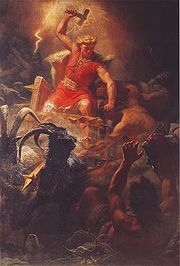July 29
Almost a thousand years after he sailed the fjords of Norway, King Olaf is remembered with Olavsfestdagen (Olaf’s Feast Day) — a week of music, entertainment, and partying.
Legends abound of King Olaf’s heroic deeds. According to “Scandanavian Folk-lore – Illustrations of the Tradition Beliefs of the Northern Peoples”
When St. Olaf came to the farm of Sten, where his mother is said to have lived, he resolved to build a church there. A giantess, who at the time lived in the mountain…was not at all satisfied with this plan…and challenged him to a contest. “Before you are finished with your church,” said she, “I shall have built a stone bridge over Stensfirth.” Olaf accepted the challenge, and before she was half finished with the bridge, the glorious peal of the bells was heard from St. Olaf’s Church.
In a rage the troll seized the stones with which she had intended to complete the bridge, and hurled them…over the firth at the church, but as none of them struck it, she became so angry that she cut off one of her legs and let that fly at the steeple… [T]he leg landed in a bog behind the church, where to this day it causes a bad smell.
Despite the stories, Olav was not always the saintliest of saints. So scribed Sigvald the skald:
The youthful king stain red the hair
Of Angeln men, and dyed his spear
At Newport in their hearts’ dark blood;
And where the Danes the thickest stood–
Where the shrill storm round Olaf’s head
Of spear and arrow thickest fled,
There thickest lay the Thing-men dead!
Nine battles now of Olaf bold,
Battle by battle, I have told

Yes, Olaf had a tendency to convert Scandanavia’s pagan remnants, not with scripture and Bibles but with sword, fire, and battle-axe.
He was slain in battle in 1030, his body buried near the field, to be later disinterred and moved to Trondheim…
where it was deposited in the magnificent cathedral which rose upon the ruins of the temple of Thor. The recollection of his cruelties was forgotten, and such was the reverence paid to him as a hero and martyr that he might almost be said to have filled the place of the ancient idols in the affections of the nation.
In death the former king became more powerful than in life. Having uprooted centuries of pagan myth and tradition, Olaf himself replaced the Norse god Thor in some ways. He inherited the god’s red hair and beard, and the weapon of choice was changed from hammer to Olaf’s battle-axe.

In death, Olaf’s powers had no bounds. His shrines were said to heal the sick, make strong the weak, and even to heal crippled and severed limbs–though whether this is related to his encounter with the angry giantess at Stensfirth, and the smell emanating from the bog behind his church, the sagas do not say.


